Understanding Qualcomm's Snapdragon 810: Performance Preview
by Joshua Ho & Andrei Frumusanu on February 12, 2015 9:00 AM EST- Posted in
- SoCs
- Qualcomm
- Mobile
- Gobi
- Snapdragon 810
GPU Performance
Last but certainly not least, we have GPU performance. As we mentioned earlier, the Snapdragon 810 introduces Qualcomm's Adreno 430, the latest member of the Adreno 400 GPU family. Qualcomm's own performance estimates call for a 30% increase over Adreno 420, with a final GPU clock of 600MHz being identical to the Snapdragon 805's (Adreno 420) own GPU clock speed.
From an architectural standpoint Adreno continues to be something of a black box for us. Other than being a modern OpenGL ES 3.1/AEP design, we don't know too much about how the GPU is laid out, and Qualcomm's current legal battle with NVIDIA likely not helping matters. In any case, Qualcomm has indicated that Adreno 430 is not just a simple extension of Adreno 420, so we may be looking at an architectural change such as wider shader blocks.
For today's benchmarks, as we mentioned before we only had a limited amount of time with the Snapdragon 810 and had issues with BaseMark X. We've had to pare down our GPU benchmarks to just 3DMark 1.2 and GFXBench 3.0. Once we get final hardware in, we will be able to run a wider array of graphics benchmarks on Snapdragon 810.
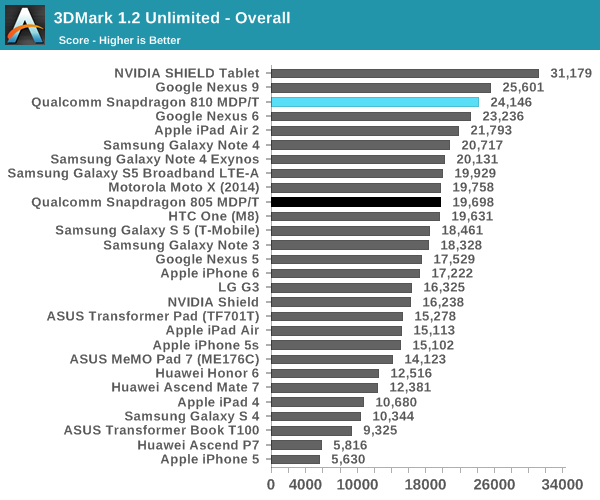
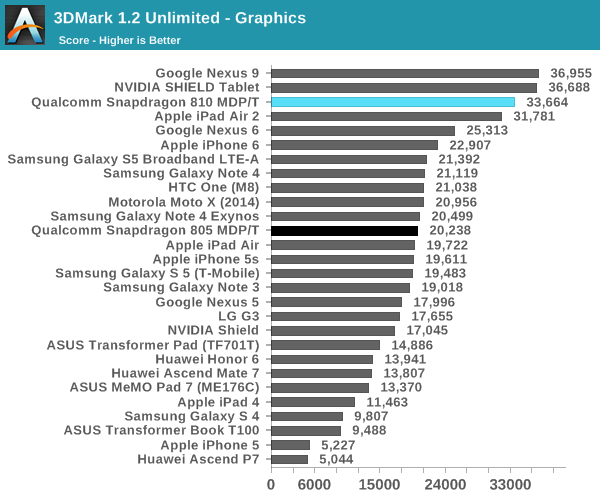
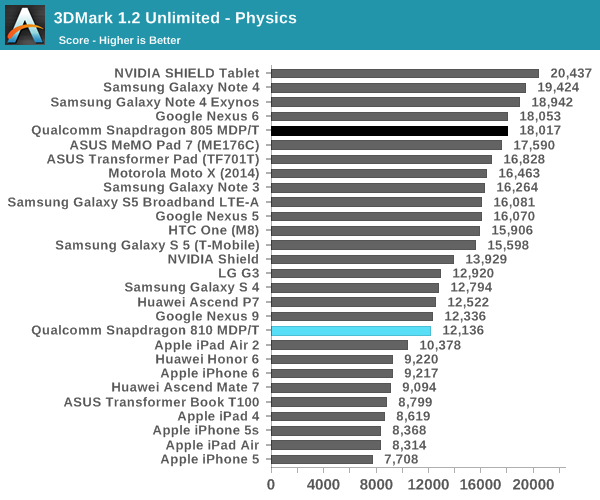
Starting off with 3DMark, compared to the Snapdragon 805 reference platform the actual graphics performance advantage is even greater than 30%, coming in at closer to 65%. However since drivers play a big role in this, a more recent 805 platform like the Nexus 6 may be a better comparison point, in which case the gains are 33%, just a hair over Qualcomm's own baseline performance estimate. We also find that Snapdragon 810 oddly struggles at physics performance here, underperforming Snapdragon 805 devices, something the Exynos 5433 didn't have trouble with. As a result overall performance is only slightly improved over the Nexus 6.
Continuing with GFXBench, we look at more pure GPU loads. One has to take note that the MDP/T employs a 4K screen resolution, and the on-screen results will likely suffer from that.

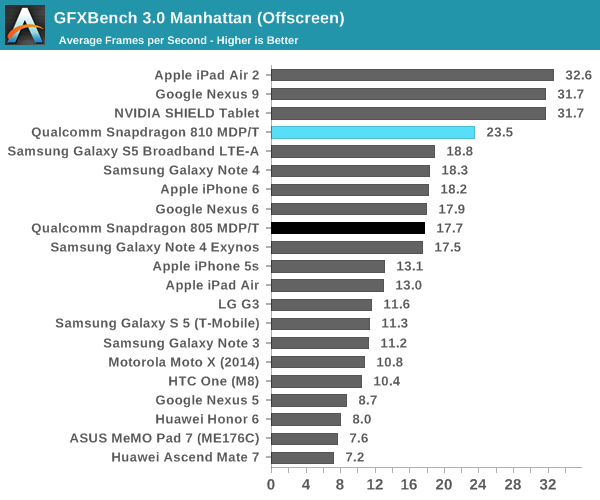
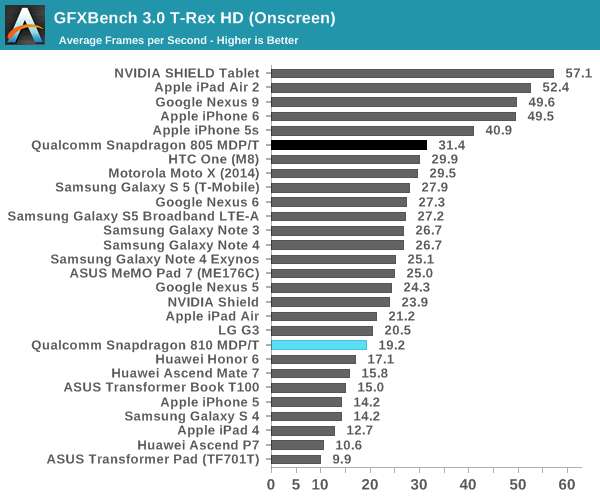
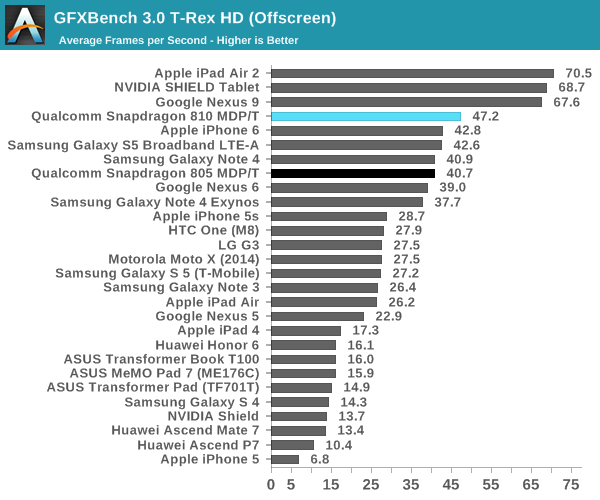
Under GFXBench 3.0's full rendering tests of Manhattan and T-Rex, the Snapdragon 810 continues to show considerable performance gains over the Snapdragon 805. Ignoring the onscreen results for now since the Snapdragon 810 reference platform runs at such a high resolution, offscreen results show the 810 outperforming the 805 by 33% in Manhattan and 16% in T-Rex. The former is again well in-line with Qualcomm's performance estimate, wile the older T-Rex benchmark doesn't show the same gains, possibly indicating that Adreno 430's biggest gains are going to come from shader-bound scenarios.
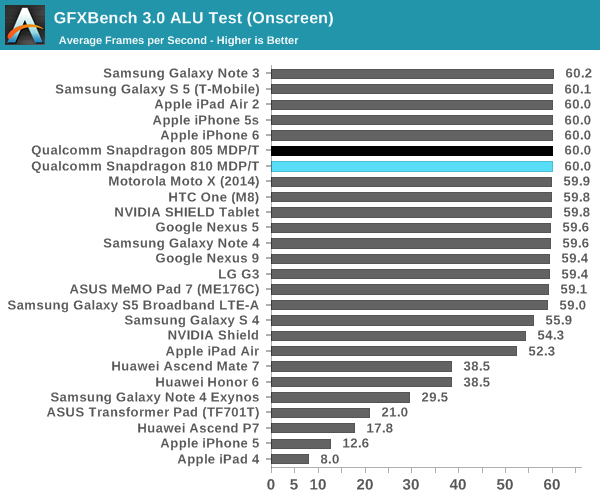
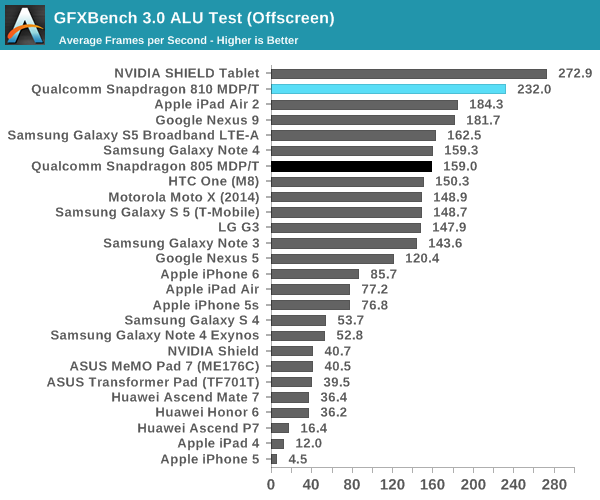

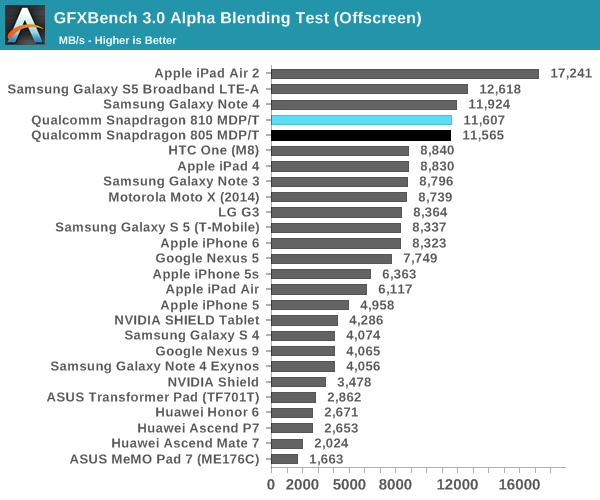
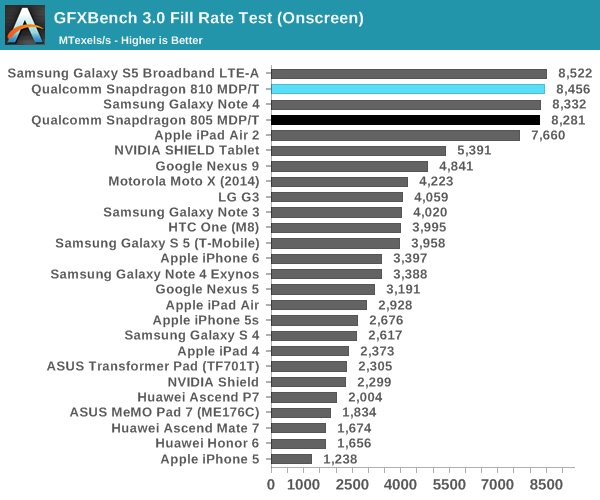
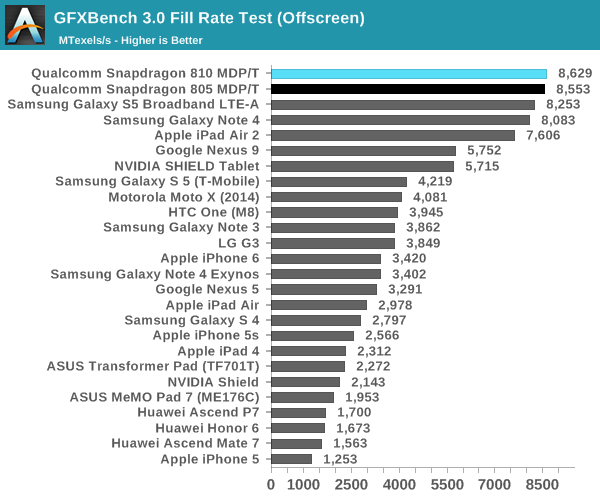
Meanwhile GFXBench's synthetic tests continue to put Adreno 430 and the Snapdragon 810 in a good light. ALU performance in particular is showing very large gains - 46% better than the Snapdragon 805 and Adreno 420 - while our blending and fillrate tests show almost no gain over Snapdragon 805. This adds further credence to our theory that Qualcomm has widened or otherwise improved Adreno's shader blocks for 430, as other elements of the GPU are not showing significant performance changes.
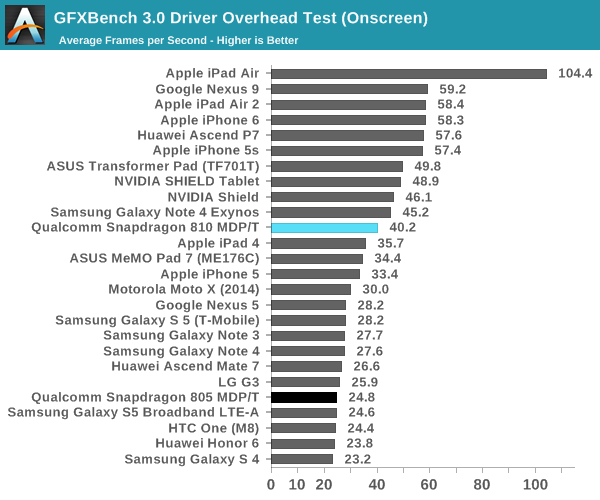
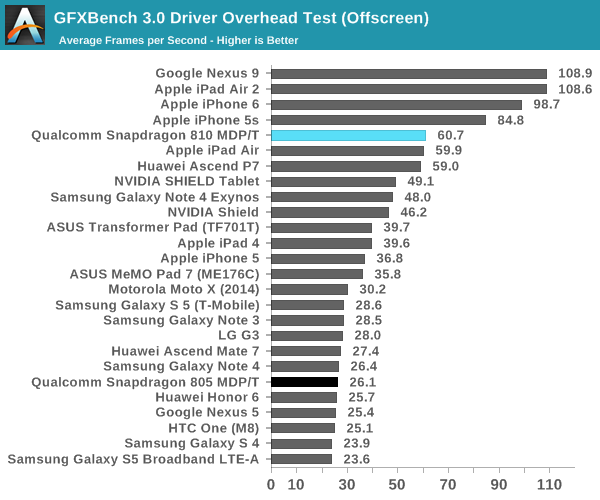
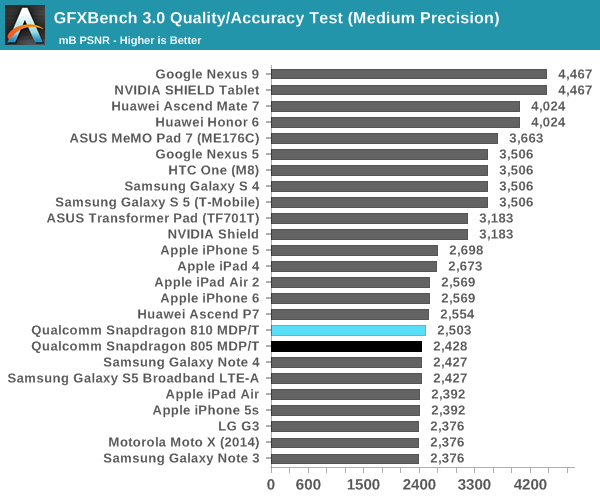

Finally, GFXBench's driver overhead and accuracy tests are more or less what we would expect for Snapdragon 810. In the case of driver overhead, a combination of newer drivers and a much faster CPU have reduced the CPU cost of driver overhead. Meanwhile with the underlying GPU architecture being unchanged, there are no material changes to quality/accuracy.
Overall then the performance gains for the Adreno 430 and Snapdragon 810 seem to be almost exclusively focused on shader performance, but in those cases where rendering workloads are shader bound, Qualcomm's 30% estimate is on the mark. Real-word performance gains meanwhile are going to depend on the nature of the workload; games and applications that are similarly shader-bound should see good performance gains, while anything that's bottlenecked by pixel throughput, texturing, or front-end performance will see much smaller gains. Thankfully for Qualcomm most high-end workloads are indeed shader bound, and this is especially the case when pushing high resolutions, as Qualcomm is trying to do with their 4K initiative for Snapdragon 810. However in the case of 4K, while Adreno 430 offers improved performance it's still slow enough that it's going to struggle to render any kind of decently complex content at that resolution.
As for Adreno 430 versus the competition, Qualcomm has narrowed much of the gap between themselves and NVIDIA/Apple, but they haven't closed it. Apple's Imagination GX6850 and NVIDIA's K1 GPUs continue to hold a performance advantage, particularly in GFXBench's Manhattan and T-Rex full rendering tests. Both Apple and NVIDIA invested significant die space in graphics, and while we don't know how much Qualcomm has invested in Adreno 430 with Snapdragon 810, it's safe to say right now that they would need to invest even more if they want to beat the graphics performance of NVIDIA and Apple's tablet SoCs.










119 Comments
View All Comments
TerdFerguson - Thursday, February 12, 2015 - link
I'm inclined to agree with you, especially after seeing the dual-channel 32-bit bus being described as having a total of 64 bits. Wow, that's as bad as marketing for 1990s consoles.extide - Thursday, February 12, 2015 - link
How is that bad marketing? A dual channel 32-bit bus IS effectively 64-bits wide ...dawheat - Thursday, February 12, 2015 - link
The reference platform has a 6.2” display - making it quite the gigantic phone. I'm guessing it avoids thermal issues which may impact other, more normal size phones.Andrei Frumusanu - Thursday, February 12, 2015 - link
The preview tests were actually done on the MDP tablet, not the MDP phone.dawheat - Thursday, February 12, 2015 - link
Ouch - then this is really best-case performance of the S810 as I'd imagine the tablet MDP has way higher thermal headroom than the phones it's being compared to.lopri - Thursday, February 12, 2015 - link
I am usually very harsh on reviewers, but I do not think your argument holds up. Exynos 5433 is a vanity product. While technically interesting, it is used for one product (afaik) and even that product is not widely available. I would definitely prefer to learn the improvement of the S810 over S800/S805, being Qualcomm's generational product.And it is not like the review tried to hide the Exynos 5433 or anything. The numbers are right there for you to see. Furthermore, AT covered the Exynos 5433 very extensively only a few days ago.
Likewise, throttling or power is meaningless at this stage without knowing what the shipping product is going to be like. And I expect to see those information in due time. Unless you can point to false benchmark data, I do not see the merit in picking on every single aspect of an SOC that was not covered (yet).
Not everyone wants to read corporate conspiracy theories on a tech article, either. I, for one, do not like to read unverified rumors in a technical article.
Only thing that I agree with you about is the missing clock frequency information on the charts. But again, the focus is rightfully on S805 v. S810. I will give the authors a benefit of doubt.
Only thing that I do not like about the article is its timing. I mean, I haven't even finished the Exynos 5433 article yet and there are already 2 laptop articles and now an introduction to the S810.. It's too much information for me to digest. Obviously this is a subject point, and I do not expect everyone to agree with me.
warreo - Thursday, February 12, 2015 - link
Exynos 5433 is indeed a vanity product, nobody is arguing otherwise. You are missing the point that I made earlier. Exynos 5433 is the immediate predecessor to the 7420. Hence, comparing the S810 to the 5433 is a good starting point for how the S810 will compare to the 7420, and it would be one completely based on real, hard data, not just speculation. Are you honestly saying that you would not be interested in a better preview of how the S810 vs. Exynos 7420 will shake out?lopri - Thursday, February 12, 2015 - link
I mean, if AT really wanted to boost S810's image the authors could have omitted the number from 5433 in Geekbench sub-score comparison. The rest of the charts also look free of manipulation, so I do not see how you get the impression.As you can see from this very comment section, not everyone is impressed by the S810. Apparently the authors did not do a good enough job - you know, the job you are insinuating here.
warreo - Thursday, February 12, 2015 - link
True enough, but the fact that AT provides the 5433 data makes it more mystifying why they almost completely gloss over it in the text (not to mention not provide the % differences in the tables). Josh and Andrei have already stated they intentionally kept the focus on S805 vs. S810, but my point is this would be a much stronger article if there was more depth given to the Exynos 5433 comparison. Clearly, I'm not the only one who thinks so.Tchamber - Friday, February 13, 2015 - link
@warreoGet over yourself. So far the 5433 has made it into one product. We all know that it's a good performer, but the Snapdragon line makes it into many more devices...always has. What your asking would be like me writing to Car and Driver and saying "hey, you are guys are doing your comparisons wrong. I want you test your Corvettes, Camarros, and GT500s against a Lamborghini Aventador." Well, they have all the test results from the Lamobo...but that's just not what the others were made to compete with, so it would be meaningless to run them against each other at the road course. Do your own math if you don't like not seeing a percent sign with easy to digest material. All the time you've been talking down to AT you could have posted your own conclusions and helped out all those people who agree with you.